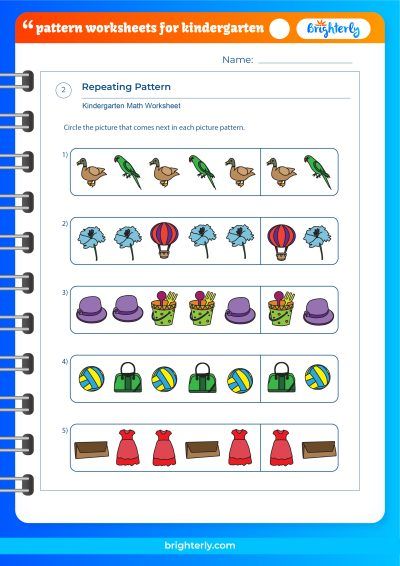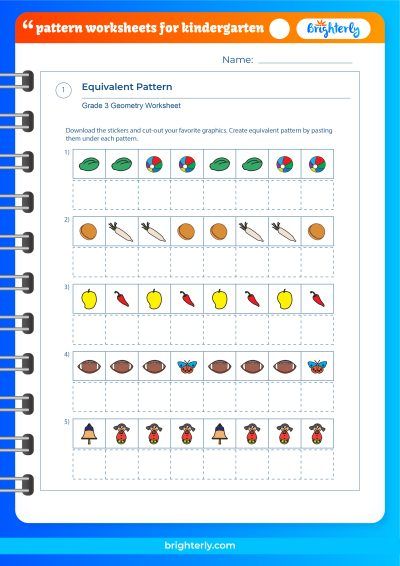Patterns – Definition With Examples
Updated on January 14, 2024
Here at Brighterly, we’re passionate about making the abstract world of mathematics accessible and exciting for children. Today, we’re taking you on a journey through the fascinating realm of patterns, a crucial concept in mathematics and an omnipresent aspect of our everyday lives.
Patterns exist everywhere – from the rhythmic beats of your favorite music, the beautifully intricate designs on a butterfly’s wings, to the daily routines that structure our lives. Patterns are also deeply interwoven into the fabric of mathematics, establishing a framework of predictability and order amidst the apparent chaos of numbers.
As a fundamental concept in mathematics, patterns are something children begin learning at an early age. Grasping patterns paves the way for developing strong problem-solving skills, honing in on observational prowess, and deepening their understanding of mathematical concepts. In this comprehensive guide, we’ll delve into the definition of patterns, their types, and rules, along with engaging examples that will illuminate this captivating topic.
Patterns Definition
We encounter patterns every day without even realizing it. They’re in nature, in architecture, in music, and even in our daily routines. However, do you know what a pattern in mathematics means? Well, it’s not too different from what you may already know.
In mathematics, a pattern can be described as a repeated design or recurring sequence. An arrangement of numbers, shapes, or objects that follow a specific rule or set of rules. For instance, if you have a sequence of numbers like 2, 4, 6, 8, 10, you’ll notice that every number is 2 more than the previous one. This is an example of a simple pattern.
Patterns are a core concept in mathematics and it’s one that students begin learning at a very early age. By studying patterns, children enhance their observational skills, improve their problem-solving abilities, and understand math concepts more deeply.
Let’s take a closer look at some types of patterns and explore examples of each.
Finite Patterns
A finite pattern is a sequence or design that has a definite end. This could be a row of shapes in a specific order, or a list of numbers that stops after a certain point. For instance, consider a pattern of squares and circles: square, circle, square, circle, square. This pattern has a definite end; after the last square, there’s nothing else. Finite patterns are often used in mathematics to introduce the concept of patterns to young learners because they are easy to recognize and understand.
Infinite Patterns
In contrast to finite patterns, infinite patterns go on forever, they never end. These types of patterns can be found in number sequences. For example, the sequence of even numbers (2, 4, 6, 8, 10…) is an infinite pattern. You could keep adding 2 to the last number and you’ll never run out of new numbers to add to the sequence.
These patterns can be a bit more challenging for kids to grasp because they require understanding the rule that defines the pattern rather than just seeing what object or number comes next.
Rules of Pattern
Every pattern follows a rule, a defined way it progresses or changes. The rule of a pattern might involve a simple operation like addition or subtraction, or it could be something more complex. For instance, the pattern “2, 4, 6, 8, 10” follows the rule “add 2”. Understanding the rule of a pattern is key to being able to extend the pattern or find missing elements in a sequence.
Repeating Pattern
A repeating pattern involves a sequence of numbers or objects that repeat over and over again. The sequence could be as simple as “1, 2, 1, 2, 1, 2” or as complex as “2, 3, 5, 2, 3, 5”. Once the repeating unit is identified, the pattern can be extended indefinitely. Repeating patterns are commonly found in art, music, and nature, as well as mathematics.
Growing Pattern
In a growing pattern, each step or stage of the pattern increases by a certain rule. For example, consider the pattern “3, 6, 9, 12”. Each number in the pattern is 3 more than the last. You can keep adding 3 to extend the pattern. Growing patterns are common in mathematical problems and real-life situations such as calculating interest or measuring growth.
Shrinking Pattern
Opposite to growing patterns, shrinking patterns decrease at each step. For instance, the pattern “20, 15, 10, 5” follows the rule “subtract 5”. Just as growing patterns, shrinking patterns also have numerous applications in the real world, like measuring depreciation or understanding some natural phenomena.
Types of Patterns
Patterns come in a variety of forms and can involve different types of objects or elements. Let’s discuss a few examples.
1. Shape Pattern
A shape pattern is a sequence that uses geometric shapes to create a design. This could be a simple pattern like “circle, square, circle, square” or a more complex pattern involving different shapes and colors. Shape patterns are often used in primary grades to teach children about basic geometry and pattern recognition.
2. Letter Pattern
Letter patterns use letters instead of numbers or shapes. They could be simple sequences like “A, B, A, B” or patterns that follow alphabetical order like “A, B, C, A, B, C”. These patterns help children understand the sequence of the alphabet and can also be used in word games and puzzles.
3. Number Pattern
A number pattern is a sequence of numbers that follows a certain rule. This could be a simple arithmetic sequence like “2, 4, 6, 8” (where you add 2 each time) or a more complex geometric sequence like “2, 4, 8, 16” (where you multiply by 2 each time). Number patterns are used extensively in mathematics to teach a variety of concepts.
At Brighterly, we believe that practice is the key to mastery. That’s why we invite you to explore our pattern worksheets, where you can find an array of additional practice questions, complete with answers.
Number Patterns
Number patterns are a staple in math education. They help students learn the basics of addition, subtraction, multiplication, and division, and set the stage for more advanced mathematical concepts. Let’s explore a few types of number patterns.
Arithmetic Pattern
An arithmetic pattern is a number sequence in which the difference between any two consecutive numbers is constant. This means that the same number is either added or subtracted each time. For example, the sequence “5, 10, 15, 20, 25” is an arithmetic pattern because we are adding 5 each time.
Geometric Pattern
A geometric pattern is a number sequence in which the ratio between any two consecutive numbers is constant. This means the same number is either multiplied or divided each time. For instance, the sequence “3, 6, 12, 24, 48” is a geometric pattern because each number is twice as large as the previous one.
Fibonacci Pattern
The Fibonacci pattern is a special type of number sequence where each number is the sum of the two preceding ones. It starts with 0 and 1, and continues like this: 0, 1, 1, 2, 3, 5, 8, 13, 21, and so on. The Fibonacci sequence finds its applications in various fields such as mathematics, science, and art.
Solved Examples on Patterns
Understanding patterns can be a lot more fun when we solve some examples. Let’s take a look at some solved examples that demonstrate different types of patterns.
-
Example 1: Consider the number pattern “5, 10, 15, 20”. What’s the next number? Well, the pattern is increasing by 5 each time, so the next number would be 20 + 5 = 25.
-
Example 2: Look at this shape pattern: triangle, circle, triangle, circle. What shape comes next? The pattern is alternating between a triangle and a circle. So, after the circle, the next shape should be a triangle.
Practice Questions on Patterns
Now that we’ve discussed different types of patterns and seen some examples, it’s time for some practice. See if you can solve these pattern problems on your own:
- Question 1: What comes next in the number sequence “4, 8, 12, 16”?
- Question 2: In the letter pattern “A, C, E, G”, what letter comes next?
- Question 3: What comes next in the shape pattern “star, square, star, square”?
Conclusion
Patterns – an underlying structure that organizes surfaces or structures in a consistent, regular manner. While it might seem like a simple concept, understanding patterns is a key stepping stone in a child’s mathematical journey. At Brighterly, our mission is to unravel these seemingly complex mathematical concepts into digestible and enjoyable lessons for children.
The knowledge of patterns transcends the boundaries of mathematics, linking to different areas of life, science, and even art. Recognizing and interpreting patterns prepares children not just for more advanced math but also for many life situations that require problem-solving and logical thinking.
Remember, patterns aren’t just a list of numbers – they’re a tool for understanding the world around us. So, the next time you see a pattern, whether in a math problem, in a piece of music, or in the changing seasons, take a moment to appreciate its beauty and universality.
Frequently Asked Questions on Patterns
What is the importance of studying patterns in mathematics?
Patterns form the basis for understanding many aspects of life, not just math. Recognizing patterns is a fundamental skill, relevant to all fields of learning. In mathematics, patterns can help children predict the next number or shape in the series. It can also help them understand relationships between numbers, thereby enhancing their problem-solving and reasoning skills. More importantly, understanding patterns gives kids a better grasp of mathematical concepts, making it easier for them to learn new concepts in the future.
How are patterns used in the real world?
Patterns are everywhere in the real world! Weather scientists use patterns to predict future climate conditions. Economists use them to anticipate future market trends. In the field of technology, algorithms (a set of instructions to solve a problem) are often designed based on patterns. In music, patterns are used to create rhythm and structure. Even in nature, patterns are found in many places – the symmetry in leaves, the complex designs on animal fur, the rotation of the earth, and so much more. Recognizing and understanding patterns, therefore, can be useful in a variety of real-world situations.
Are patterns important for children’s cognitive development?
Yes, understanding patterns is crucial for a child’s cognitive development. Patterns help children make predictions and make sense of their environment. They can establish order and enhance a child’s ability to make logical connections and associations. In mathematics, a strong understanding of patterns can contribute to a child’s ability to comprehend the relationships between numbers and develop effective problem-solving strategies.
Remember, at Brighterly, we’re here to make the world of mathematics a fun and engaging experience. With patterns all around us, the world becomes a fascinating playground for both learning and discovery!






